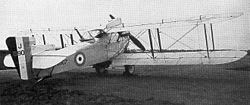| Fawn | |
|---|---|
 | |
| General information | |
| Type | Two-seat day light bomber |
| National origin | United Kingdom |
| Manufacturer | Fairey Aviation |
| Designer | F Duncanson |
| Primary user | Royal Air Force |
| Number built | 75 |
| History | |
| Introduction date | 1924 |
| First flight | 1923 |
| Retired | 1929 |
The Fairey Fawn was a British single-engine light bomber of the 1920s. It was designed as a replacement for the Airco DH.9A and served with the Royal Air Force between 1924 and 1929.


